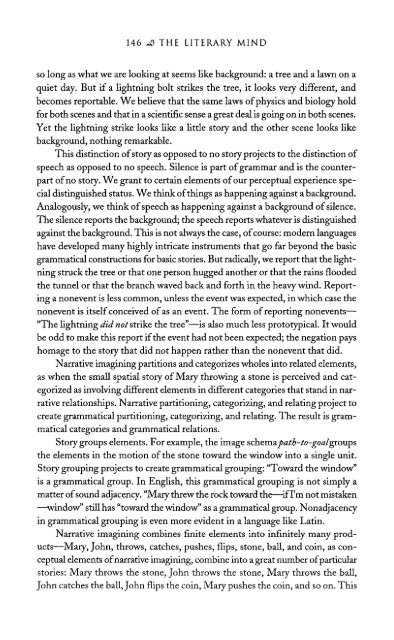The Literary Mind.pdf
The Literary Mind.pdf
The Literary Mind.pdf
Create successful ePaper yourself
Turn your PDF publications into a flip-book with our unique Google optimized e-Paper software.
146 THE LITERARY MIND<br />
so long as what we are looking at seems like background: a tree and a lawn on a<br />
quiet day. But if a lightning bolt strikes the tree, it looks very different, and<br />
becomes reportable. We believe that the same laws of physics and biology hold<br />
for both scenes and that in a scientific sense a great deal is going on in both scenes.<br />
Yet the lightning strike looks like a little story and the other scene looks like<br />
background, nothing remarkable.<br />
This distinction of story as opposed to no story projects to the distinction of<br />
speech as opposed to no speech. Silence is part of grammar and is the counterpart<br />
of no story. We grant to certain elements of our perceptual experience special<br />
distinguished status. We think of things as happening against a background.<br />
Analogously, we think of speech as happening against a background of silence.<br />
<strong>The</strong> silence reports the background; the speech reports whatever is distinguished<br />
against the background. This is not always the case, of course: modern languages<br />
have developed many highly intricate instruments that go far beyond the basic<br />
grammatical constructions for basic stories. But radically, we report that the lightning<br />
struck the tree or that one person hugged another or that the rains flooded<br />
the tunnel or that the branch waved back and forth in the heavy wind. Reporting<br />
a nonevent is less common, unless the event was expected, in which case the<br />
nonevent is itself conceived of as an event. <strong>The</strong> form of reporting nonevents—<br />
"<strong>The</strong> lightning did not strike the tree"—is also much less prototypical. It would<br />
be odd to make this report if the event had not been expected; the negation pays<br />
homage to the story that did not happen rather than the nonevent that did.<br />
Narrative imagining partitions and categorizes wholes into related elements,<br />
as when the small spatial story of Mary throwing a stone is perceived and categorized<br />
as involving different elements in different categories that stand in narrative<br />
relationships. Narrative partitioning, categorizing, and relating project to<br />
create grammatical partitioning, categorizing, and relating. <strong>The</strong> result is grammatical<br />
categories and grammatical relations.<br />
Story groups elements. For example, the image schema path-to-goa/ groups<br />
the elements in the motion of the stone toward the window into a single unit.<br />
Story grouping projects to create grammatical grouping: "Toward the window"<br />
is a grammatical group. In English, this grammatical grouping is not simply a<br />
matter of sound adjacency. "Mary threw the rock toward the—if I'm not mistaken<br />
—window" still has "toward the window" as a grammatical group. Nonadjacency<br />
in grammatical grouping is even more evident in a language like Latin.<br />
Narrative imagining combines finite elements into infinitely many products—Mary,<br />
John, throws, catches, pushes, flips, stone, ball, and coin, as conceptual<br />
elements of narrative imagining, combine into a great number of particular<br />
stories: Mary throws the stone, John throws the stone, Mary throws the ball,<br />
John catches the ball, John flips the coin, Mary pushes the coin, and so on. This















